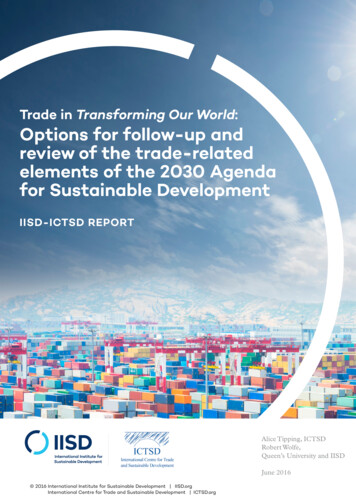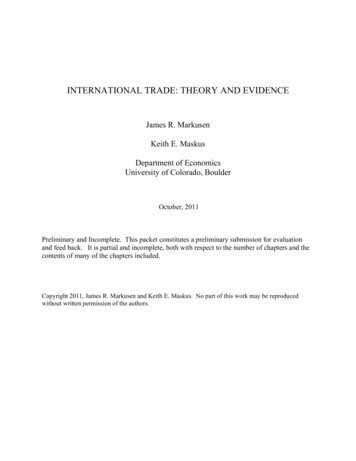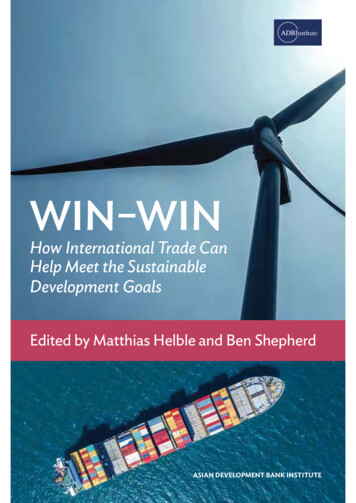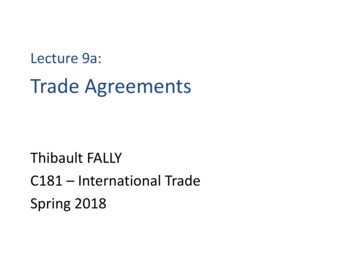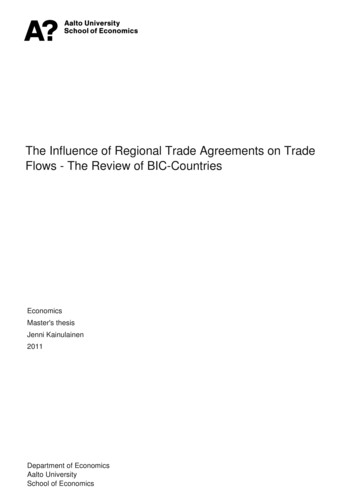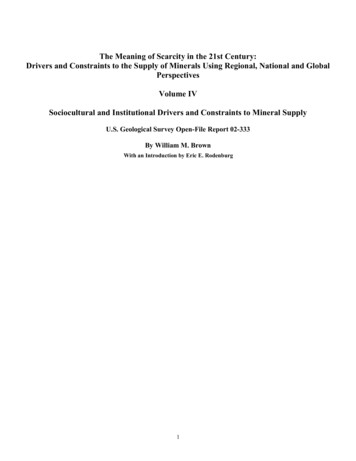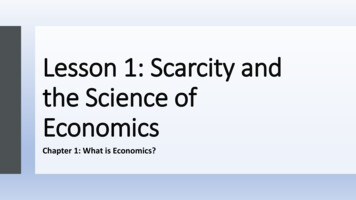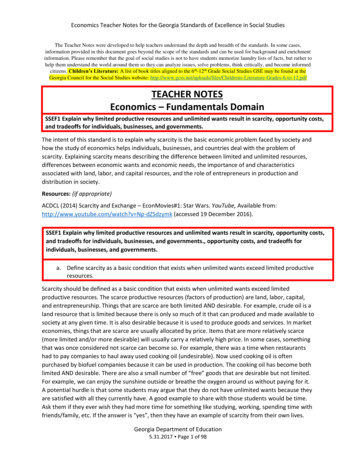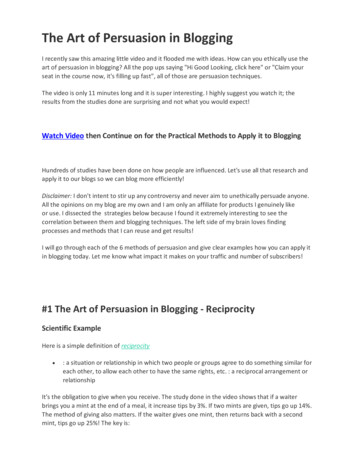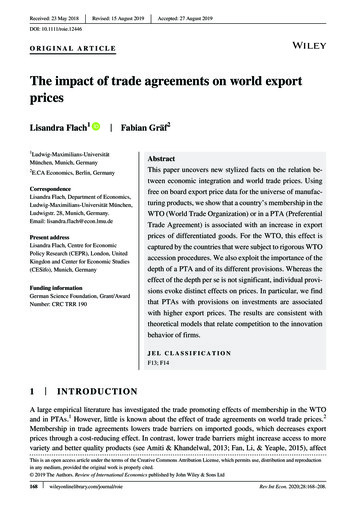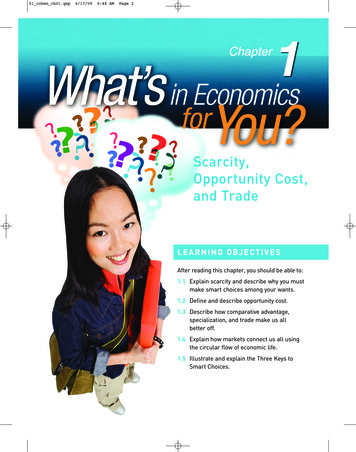
Transcription
01 cohen ch01.qxp4/17/099:48 AMPage 2Scarcity,Opportunity Cost,and TradeL E A R N I N G O BJ E CT I V E SAfterWhy4.1readingare coststhis chapter,based onyouopportunityshould be ablecosts,to:not scarcityon objectiveinputs? why you must1.1 andExplainand describe4.2 Whymakedon’tsunkcostsamongmatteryourfor futuresmartchoiceswants.choices?1.2 Define and describe opportunity cost.4.3do producerschoose theirquantity1.3 HowDescribehow comparativeadvantage,supplied?The lawsupply.specialization,and oftrademake us all4.4 betterHow dooff.we find market supply from indisupply decisions?1.4 vidualExplainfirms’how marketsconnect us all usingcircular4.5 theWhatchangesmarketsupply?life.flowof economic4.6 Byhow muchdoes quantitysupplied1.5Illustrateand explainthe ThreeKeys torespondSmartChoices.to a change in price?
01 cohen ch01.qxp4/17/099:48 AMPage 3WHAT DO YOU WANT OUT OF LIFE? Riches? Fame?Love? Adventure? A successful career? To make the world a better place?To live a life that respects the environment? To express your creativity?Happiness? Children? A long and healthy life? All of the above?Economics will help you get what you want out of life. Manypeople believe economics is just about money and business. But thereal definition of economics is how individuals, businesses, andgovernments make the best possible choices to get what they want,and how those choices interact in markets.The title of this book comes from a quote by Nobel Prize-winningauthor George Bernard Shaw: “Economy is the art of making themost of life.” Economics is partly about getting the most for yourmoney, but it is also about making smart choices generally. I wrotethis book because I believe that if you learn a little economics, it willhelp you make the most of your life, whatever you are after. Thatsame knowledge will also help you better understand the worldaround you and the choices you face as a citizen.You don’t need to be trained as an economist to lead a productiveand satisfying life. But if you can learn to think like an economist, youcan get more out of whatever life you choose to lead, and the worldwill be better for it.economics:how indivibusiness duals,es, andgovernmenbest poss ts make theibget what le choices tothand how ey want,those choiinteractin marke cests
01 cohen ch01.qxp4/17/091.19:48 AMPage 4Are You Getting Enough?Scarcity and ChoiceExplain scarcity anddescribe why youmust make smartchoices among yourwants.sscarcity:hat arisetmelboethe pre all hav ,wesuaceby, timeenomdelimitgyand enerCan you afford to buy everything you want? If not, every dollar you spend involvesa choice. If you buy the Nintendo Wii, you might not be able to afford yourEnglish textbook. If you treat your friends to a movie, you might have to work anextra shift at your job or give up your weekend camping trip.It would be great to have enough money to buy everything you want, but itwould not eliminate the need to make smart choices. Imagine winning the biggestlottery in the world. You can buy whatever you want for yourself, your family,and your friends. But you still have only 80-some years on this planet (if you arelucky and healthy), only 24 hours in a day, and a limited amount of energy. Do youwant to spend the week boarding in Whistler or surfing in Australia? Do youwant to spend time raising your kids or exploring the world? Will you go to thatthird party on New Year’s Eve or give in to sleep? Do you want to spend money onyourself, or set up a charitable foundation to help others? Bill Gates, one of therichest people on Earth, has chosen to set up the Bill and Melinda GatesFoundation. With billions of dollars in assets, the Foundation still receives morerequests for worthy causes than it has dollars. How does it choose which requeststo fund?Economists call this inability to satisfy all of our wants the problem of scarcity.Scarcity arises from our limited money, time, and energy. All mortals, evenbillionaires, face the problem of scarcity. We all have to make choices about whatwe will get and what we will give up. Businesses with limited capital have to choosebetween spending more on research or on marketing. Governments have to makesimilar choices in facing the problem of scarcity. Spending more on colleges anduniversities leaves less to spend on health care. Or if governments tried to spendmore on all social programs, the higher taxes to pay for them would mean less takehome pay for all of us.Because none of us — individuals, businesses, governments — can ever satisfyall of our wants, smart choices are essential to making the most of our lives.fresRe h1.11. Define scarcity.2. What does the definition of economics have to do with scarcity?www.myeconlab.com4CHAPTER 13. Social activists argue that materialism is one of the biggest problems with society:If we all wanted less, instead of always wanting more, there would be plenty to goaround for everyone. What do you think of this argument?WHAT’S IN ECONOMICS FOR YOU?
01 cohen ch01.qxp1.24/17/099:48 AMPage 5Give It Up for Opportunity Cost!Opportunity CostScarcity means you have to choose, and if you want the most out of what limitedmoney and time you have, you need to make smart choices. A choice is like afork in the road. You have to compare the alternatives and then pick one. Youmake a smart choice by weighing benefits and costs.Define and describeopportunity cost.Choose to Snooze?What are you going to do with the next hour? Since you arereading this, you must be considering studying as one choice. Ifyou were out far too late last night, sleep might be your alternativechoice. If those are your top choices, let’s compare benefits ofthe two paths from the fork. For studying, the benefits are highermarks on your next test, learning something, and (if I have donemy job well) perhaps enjoying reading this chapter. For sleep,the benefits are being more alert, more productive, less grumpy,and (if I have done my job poorly) avoiding the pain of readingthis chapter.If you choose the studying path, what is the cost of yourdecision? It is the hour of sleep you give up (with the benefits ofrest). And if you choose sleep, the cost is the studying you give up (leading tolower marks).In weighing the benefits and costs of any decision, we compare what we getfrom each fork with what we give up from the other. For any choice (what weget), its true cost is what we have to give up to get it. The true cost of any choiceis what economists call opportunity cost: the cost of the best alternative given up.opportunitycost of b cost:esgiven up t alternativeOpportunity Cost Beats Money CostFor smart decisions, it turns out that opportunity cost is more important thanmoney cost. Suppose you win a free trip for one to Bermuda that has to betaken the first week in December. What is the money cost of the trip? (Thisis not a trick question.) Zero — it’s free.But imagine you have a business client in Saskatoon who can meet tosign a million-dollar contract only during the first week in December. What isthe opportunity cost of your “free” trip to Bermuda? 1 million. A smart decisionto take or not take the trip depends on opportunity cost, not money cost.Or what if you have an out-of-town boyfriend, and the only time you canget together is during the first week in December? What is the opportunity cost oftaking your “free” trip for one? Besides losing out on the benefits of time together,you may be kissing that relationship goodbye.All choices are forks in the road, and the cost of any path taken is the value ofthe path you must give up. Because of scarcity, every choice involves a trade-off —to get something, you have to give up something else. To make a smart choice, thevalue of what you get must be greater than the value of what you give up. The benefitsof a smart choice must outweigh the opportunity cost.FOR YOUR INFORMATIONIf there were an official slogan forthe concept of opportunity cost, itwould be, “There is no such thing asa free lunch.” The usual meaning of theslogan is that there are strings attachedto any gift: the giver will expect somethingin return. The economist’s take on theslogan is that every choice involves a tradeoff: To get anything, including lunch, youmust always give up something else. Whatyou give up may be money or time, butevery choice has an opportunity cost.Scarcitymeans every choicinvolves aetrade-off.SCARCITY, OPPORTUNITY COST, AND TRADE5
01 cohen ch01.qxp4/17/099:48 AMPage 6Where Have All the Men Gone?Women make up 60 percent of theundergraduate college and university population.Why do women so outnumber men? There havebeen many explanations, from women’s liberationto schools’ rewarding girls’ more obedientbehaviour and punishing boys’ ADD (attention deficitdisorder). There is also a simple economicexplanation based on opportunity cost. Think of going or not going to college oruniversity as a fork in the road.Weigh the costs and benefits of each choice.Everyone pays the same tuition and fees, butthe benefits given up with each choice aredifferent for women and men.More women than men go to college anduniversity because the cost of not going is higherfor women — men’s alternative is higher-payingblue-collar jobs. Women’s alternative tends tobe lower-paying clerical or retail jobs.:incentives d penaltiesanrewardsesfor choice, youhe prefactdaeruIf yot thisgnize thaocerthmighreeout the Tbaisniosectes,art ChoicmSotsyKein-appearwhich re.5.Section 1fresRe h1.2OOututt ThereThereWomen with post-secondary education earn 50to 80 percent more a year than women with only ahigh-school diploma. Men with the same postsecondary education earn only 25 to 30 percentmore a year than men with only a high-schooldiploma. The gap in pay between high-school andpost-secondary women is larger than the samegap for men.Because of the differences in opportunity cost— women who don’t go to college or university giveup a bigger income gain than men do — the rate ofreturn for a college diploma or university degree is9 percent for women, and only around 6 percent formen. Incentives matter, and people are respondingto the incentives. For women, it pays more to get apost-secondary education.Incentives Work Since smart choices compare costs and benefits, obviouslyyour decision will change with changes in costs or benefits. We all respond toincentives — rewards and penalties for choices. You are more likely to choose afork with a reward, and avoid a fork with a penalty. A change in incentives causesa change in choices. If your Saskatoon business deal was worth only 100 insteadof one million dollars, you might take the trip to Bermuda. If you had been outreally late last night, you would be more likely to sleep than to study. If you hada test tomorrow instead of next week, you would be more likely to study than tosleep.To make the most out of life and make smart decisions, you always need to beasking the question, “What is the opportunity cost of my choice, and do thebenefits outweigh the opportunity cost?”1. What is the opportunity cost of any choice?2. What is the biggest difference between the money cost of attending college and theopportunity cost?www.myeconlab.com6CHAPTER 13. This weekend, your top choices are going camping with your friends or workingextra hours at your part-time job. What facts (think rewards and penalties), if theychanged, would influence your decision?WHAT’S IN ECONOMICS FOR YOU?
01 cohen ch01.qxp1.34/17/099:48 AMPage 7Why Don’t You Cook Breakfast?Gains from TradeWhat did you have for breakfast today? Did you have cereal and orange juice athome, or did you buy coffee and a bagel at Tim Hortons on the way to school? Eitherway, you made a choice — to make breakfast for yourself, or to buy it from a business.This is the most basic choice you and everyone else makes in trying to do the best youcan: Do you produce yourself the products/services you want, or do you earn moneyat a job and then buy (or trade money for) products/services made by others?These days, that basic choice sounds absurd. We all work (or hope to) at jobs,earning money by specializing in a particular profession or occupation. We use thatmoney to buy what we want. Even a “homemade” breakfast uses cereal and juicebought at a supermarket. But if you go back only a few hundred years in Canadianhistory, most aboriginal peoples and pioneers were largely self-sufficient, makingfor themselves most of what they needed — hunting and growing their own food,making clothes from animal hides, and building shelters from wood.Voluntary TradeWhat happened to lead us all away from self-sufficiencytoward specializing and trading? The historical answer to that question is complex,but the simple economic answer is that specializing and trading makes us betteroff, so of course people made that basic choice. It’s simple self-interest at work.Our standard of living, in terms of material products/services, is much higherthan it was hundreds of years ago in Canada. (What we have done to theenvironment, which in the past was better than in the present, is another story thatI will also explain economically in terms of self-interest in Chapter 10.) The ironyis that as individuals we are hopeless at supporting ourselves compared to ourancestors. Yet collectively our standard of living is vastly superior.Trade is the key to our prosperity. Trade makes all of us better off. Why? Tradeis voluntary. Any time two people make a voluntary trade, each person must feelthat what they get is of greater value than what they give up. If there weren’tmutual benefits, the trade wouldn’t happen.Define and describeopportunity cost.When you “trade”money focoffee atrTim’s, thatisvoluntaryaexchange. If youthoughtyou would be betteoff keepinrg the money insteof the cofadfee, you wouldn’tpay. If Tim’s weren’t betteoff withryour money insteadof the coffee, it wouldn’t sell.Bake or Chop?It turns out that opportunity cost is the key to the mutualbenefits from trade. To illustrate, let’s take a simple imaginaryexample of two early Canadians who are each self-sufficientin producing food and shelter.Jacqueline grows her own wheat to make bread, andchops wood for fire and shelter. If she spends an entiremonth producing only bread, she can make 50 loaves.Alternatively, if she spends all her time chopping wood, shecan produce 100 cords. Her monthly choice of how to spendher time looks like this:Since Jacqueline is self-sufficient, that means she canconsume only what she produces herself, so she must divideher time and produce some bread and some wood.Figure 1.1 shows different combinations of bread and woodshe can produce, depending on how she divides up her time during the month.From these production possibilities, Jacqueline chooses to produce 20 loaves ofbread and 60 cords of wood.SCARCITY, OPPORTUNITY COST, AND TRADE7
01 cohen ch01.qxp4/17/099:48 AMPage 8Figure 1.1Jacqueline’s Production Possibilities (monthly)Bread (loaves)Wood (cords)50040203040206010800100Samantha, who lives a day’s journey away from Jacqueline, also grows herown wheat to make bread, and chops wood for fire and shelter. Samantha is olderand weaker than Jacqueline, so if Samantha spends an entire month producing onlybread, she can make 40 loaves. Alternatively, if she spends all her time choppingwood, she can produce only 20 cords.Since Samantha is also self-sufficient, and can consume only what she producesherself, she divides her time and produces some bread and some wood. Figure1.2 shows different monthly combinations of bread and wood she can produce,depending on how she divides up her time. From these production possibilities,Samantha chooses to produce 20 loaves of bread and 10 cords of wood.Figure 1.2Samantha’s Production Possibilities (monthly)Bread (loaves)Wood (cords)40030520101015020Deal or No Deal? Do the Numbersantage:vdaetulabsoroduce apotytiabilat lowerproduct st thancoabsolute oducerpranother8CHAPTER 1How could trade make both Jacqueline and Samantha better off? It doesn’t lookpromising, especially for Jacqueline. She is a better bread maker than Samantha(50 loaves versus 40 loaves) and a better wood chopper (100 cords versus 20 cords).An economist would describe Jacqueline as having an absolute advantage —the ability to produce a product/service at a lower absolute cost than anotherproducer — over Samantha in both bread production and wood production.That is, Jacqueline is more productive as a bread maker and as a wood chopper.If we were to measure dollar costs (which I have left out to keep the example assimple as possible), absolute advantage would mean Jacqueline could produceboth bread and wood at lower absolute dollar costs than could Samantha.If you are not keen on history, then in place of Jacqueline and Samantha,think China and Canada. If China can produce everything at lower cost thanCanada, can there be mutually beneficial gains from trade for both countries?What’s in it for China? Won’t all Canadians end up unemployed?WHAT’S IN ECONOMICS FOR YOU?
01 cohen ch01.qxp4/17/099:48 AMPage 9comparativability t e advantage:opproduct roduce aatopportun loweritanother y cost thanproducerComparative AdvantageBut mutually beneficial gains from trade donot depend on absolute advantage. They depend on what economists callcomparative advantage — the ability to produce a product/service at a loweropportunity cost than another producer. To figure out comparative advantage,we need to calculate opportunity costs for Jacqueline and Samantha.Jacqueline’s choice in Figure 1.1 is between producing 50 loaves of bread or100 cords of wood. If she chooses to bake 50 loaves of bread, the opportunitycost is 100 cords of wood. If she instead chooses to chop 100 cords of wood, theopportunity cost is 50 loaves of bread. Opportunity cost is the value of the fork inthe road not taken.To compare opportunity costs, it is easier if we measure them per unit of theproduct chosen. There is a simple, useful formula for opportunity cost:Opportunity cost Give UpGetSo Jacqueline’s opportunity cost of producing more bread isOpportunity cost of100 cords of wood2 cords of wood additional bread50 loaves of bread1 loaf of breadOpportunity cost of anychoice isvalue ofthe forkthe roadinnot taken.To get each additional loaf of bread, Jacqueline must give up 2 cords of wood.What is Jacqueline’s opportunity cost of producing more wood?Opportunity cost of–1 loaf of bread50 loaves of bread 2additional wood100 cords of wood1 cord of woodTo get each additional cord of wood, Jacqueline must give up –21 loaf of bread.If you calculate opportunity costs for Samantha you will find that heropportunity cost of getting an additional loaf of bread is giving up –12 cord ofwood, and her opportunity cost of getting an additional cord of wood is giving up2 loaves of bread.These opportunity cost calculations are summarized in Figure 1.3. Sincecomparative advantage is defined as lowest opportunity cost (not lowest absolutecost), you can see that Samantha has a comparative advantage in bread-making(give up –21 cord of wood versus 2 cords of wood), while Jacqueline has a comparative advantage in wood-chopping (give up –12 loaf of bread versus 2 loaves of bread).Figure 1.3Opportunity Costs for Jacqueline and SamanthaOpportunity Cost of 1 AdditionalLoaf of BreadCord of WoodJacquelineGives up 2 cords of woodGives up 1/2 loaf of breadSamanthaGives up 1/2 cord of woodGives up 2 loaves of breadComparativeAdvantageSamantha has comparativeadvantage (lower opportunitycost) in bread-makingJacqueline has comparativeadvantage (lower opportunitycost) in wood-choppingSCARCITY, OPPORTUNITY COST, AND TRADE9
01 cohen ch01.qxp4/17/099:48 AMPage 10Smart DealsHere’s the payoff to these calculations. Instead of each pioneer being self-sufficient,and producing everything she needs, look what happens if the pioneers specializein producing what each is best at, and then trade.According to comparative advantage, Jacqueline should specialize in onlychopping wood, and Samantha should specialize in only making bread. If so,Jacqueline will produce 100 cords of wood and no bread, and Samantha willproduce 40 loaves of bread and no wood. If they then make the day-long journeyand trade 20 cords of wood for 20 loaves of bread: Jacqueline ends up with 20 loaves of bread (0 produced plus 20 traded for)and 80 cords of wood (100 produced minus 20 traded away);Samantha ends up with 20 loaves of bread (40 produced minus 20 tradedaway) and 20 cords of wood (0 produced plus 20 traded for).Check it out. After trading, Jacqueline and Samantha are both better off thanwhen they were each self-sufficient. Before trade, the best Jacqueline could producewith 20 loaves of bread was 60 cords of wood, for all her strength, while aftertrade she has the same amount of bread and more wood. Before trade, the bestSamantha could produce with 20 loaves of bread was just 10 cords of wood, whileafter trade she has the same amount of bread and more wood.What is remarkable is that these gains from trade, which improve bothnot a esiJacqueline’sand Samantha’s standard of living (with more wood they can stayentradere oyrhawarmerorbuildbetter houses), happen without anyone working harder, or withoutwt,nVolu m game e other’sany improvement in technology or new resources. Both are better off because theysuth.zero- s gain isnihave made smart decisions to specialize and trade, rather than each trying toan’rs gproduce only what each will consume. Both can have toast for breakfast (breadperso th trade al gainsiBoci.fseroasted over a fire), even though each produced only part of what was necessaryysnbelolly b e causedautto make the breakfast.riveMuade a omparatrtNotice also that there are gains for both Jacqueline and Samantha, evencfrom nces inetthoughJacqueline can produce more bread and wood than Samantha can. Despiteuel.rodiffe age. Absrtant Jacqueline’s absolute advantage in producing everything at lower cost, there are stillopimntadva age is notdifferences in opportunity costs, or comparative advantage. Comparative advantagentis the key to mutually beneficial gains from trade. The trade can be betweenadvaindividuals, or between countries. That is why China trades with Canada, eventhough China can produce most things more cheaply than we can in Canada.There are still differences in comparative advantage based on opportunity costs.Trade allows us all to work smarter.So the next time you buy breakfast, don’t feel guilty about spending the moneywhen you could have cooked it yourself — feel smart about specializing andtrading to make yourself better off!fresRe h1.31. Explain the difference between absolute advantage and comparative advantage.2. If you spend the next hour working at Sears, you will earn 10. If you instead spendthe next hour studying economics, your next test score will improve by 5 marks.Calculate the opportunity cost of studying in terms of dollars given up per mark.Calculate the opportunity cost of working in terms of marks given up per dollar.www.myeconlab.com10CHAPTER 13. The best auto mechanic in town (who charges 120/hour) is also a better typist thanher office manager (who earns 20/hour). Should the mechanic do her own typing?(Hint: The best alternative employment for the office manager is another officejob that also pays 20/hour.)WHAT’S IN ECONOMICS FOR YOU?
01 cohen ch01.qxp1.44/17/099:48 AMPage 11Choosing Your Way:The Circular Flow of Economic LifeCanada is a very large country, the second largest in the world in terms ofgeographical area. Have you ever had the urge to follow in the footsteps of ourancestors and explore the land — perhaps a trip to the northernmost tip of theNorthwest Territories, or a cross-country trip from Newfoundland to BritishColumbia? No? Why not think about it?Explain how marketsconnect us all usingthe circular flow ofeconomic life.Why Maps (and Economists) Are UsefulFOR YOUR INFORMATIONThe first historical economist mostpeople think of is Adam Smith, whowrote The Wealth of Nations in 1776.But Smith was a professor of moralphilosophy ——— economics had not yetemerged as a separate subject. AlfredMarshall, as a professor of politicaleconomy at Cambridge, was the key personin professionalizing economics. Marshall’stextbook, Principles of Economics (1stedition 1890; 8th edition, 1920), is the modelthat all subsequent economics textbooks(including this one) have followed in oneway or another. How do you start planning your trip? The satellite photo of Canada below, whileamazing to look at, is not very useful. It contains too much information and toolittle information. How can that be? The photo captures every aspect of Canadathat can be seen from space — lakes, rivers, mountains, and forests. But the photodoesn’t reveal smaller details that are important for your trip — most importantly,roads, railways, or ferry services.A hybrid (combined) map version of the same photo shows you the autoroute (on the next page) along the Trans-Canada Highway (you’ve decidedit’s too cold to go up north). Why is the hybrid map so much more usefulthan the satellite photo? Because it focuses your attention on the informationthat is most relevant for your task, and leaves all other information in thebackground.Learning to think like an economist allows you to look at life like the hybridmap. The key “roads” to making smart choices start to stand out, and makingdifficult decisions and understanding the complex world around you don’t seemto be such daunting tasks.There are an almost infinite number of choices we could look at, so to keepthings manageable, let’s limit ourselves to the opening definition of economics:Economics is about how individuals, businesses, and governments make the bestpossible choices to get what they want, and about how those choices interact inmarkets. (We will look at markets more closely in Chapter 4, but for the moment,think of a market as the interaction of buyers and sellers.)Satellite photo of Canada —not useful for trip planning.SCARCITY, OPPORTUNITY COST, AND TRADE11
01 cohen ch01.qxp4/20/098:00 AMPage 12 2009 Google-Map data 2009 Tele AtlasHybrid map of part of Canadaalong the Trans-Canada Highway —useful for trip planning.Another good definition of economics was made in 1890 by Alfred Marshall,the first-ever professor of economics, who created economics as a separate subjectat the University of Cambridge. Marshall said: “Economics is the study of mankindin the ordinary business of life.”“Economics is the study ofmankind in the ordinarybusiness of life.”–Alfred Marshall (1890)Going in Circles to Find the WayEven limiting ourselves to these definitions of economics, the choices are stilloverwhelming. Imagine 35 million people spread out over 10 million squarekilometres, engaged in the “ordinary business of life,” earning a living, specializingin producing products/services, selling, and buying. Instead of trying to captureevery detail of every action and choice (like the satellite photo), Figure 1.4 showsa hybrid map version of the same economic activity.Figure 1.412CHAPTER 1Circular Flow of Economic LifeWHAT’S IN ECONOMICS FOR YOU?
01 cohen ch01.qxp4/17/099:48 AMPage 13Figure 1.4, which economists call the “circular flow of economic life,” showsyou the simplest big picture of how an economist thinks about economic choices.All the complexity of the Canadian economy is reduced to three sets of players:households, businesses, and governments. Individuals in households ultimatelyown all of the inputs of an economy — labour (the ability to work), naturalresources, capital equipment, and entrepreneurial ability. Even the assets of thelargest corporations, such as Inco, Ford, or Research In Motion, are ultimatelyowned by individual shareholders. Households and businesses interact in twosets of markets — input markets (where businesses buy the inputs they need toproduce products/services), and output markets (where businesses sell theirproducts/services). Governments (in the middle) set the rules of the game and canchoose to interact, or not, in almost any aspect of the economy.Follow the Flow Clockwise Follow the circle, starting at the top. Individualsin households sell or rent to businesses the labour, resources, capital, andentrepreneurial abilities they own. This is the outer blue flow on the right-handside of the circle, from top to bottom. In exchange, businesses pay wages andother money rewards to households. This is the inner green flow on the righthand side of the circle, from bottom to top. These exchanges, or trades, happen ininput markets, where households are the sellers and businesses are the buyers.When Mr. Sub hires you to work in a Mr. Sub store, that interaction happens inan input market—the job market.Businesses then use those inputs to produce products/services, which theysell to households. This is the outer blue flow on the left-hand side of the circle,from bottom to top. In exchange, households use the money they have earnedin input markets to pay businesses for these purchases. This is the inner greenflow on the left-hand side of the circle, from top to bottom. These exchanges, ortrades, happen in output markets, where households are the buyers and businessesare the sellers. These are markets where you buy your breakfast from a store orsupermarket, your cars from Ford or Toyota, your piercings from a neighbourhoodpiercing parlour, and so on.At the end of the trip around the circle, households have the products/servicesthey need to live, and businesses end up with the money. That sets the stage for thenext trip around the circle, where businesses again buy inputs from individuals inhouseholds, and the flow goes on.So there you have it—a hybrid map to begin your economics road trip towardunderstanding and making smart choices.It’s All Greek to Me:Microeconomics or Macroeconomics?“One size fits all” does not apply to maps. The hybrid map of Canada with thehighlighted Trans-Canada Highway may be fine for planning the big picture ofyour
The title of this book comes from a quote by Nobel Prize-winning author George Bernard Shaw: "Economy is the art of making the most of life." Economics is partly about getting the most for your money, but it is also about making smart choices generally. I wrote this book because I believe that if you learn a little economics, it will

